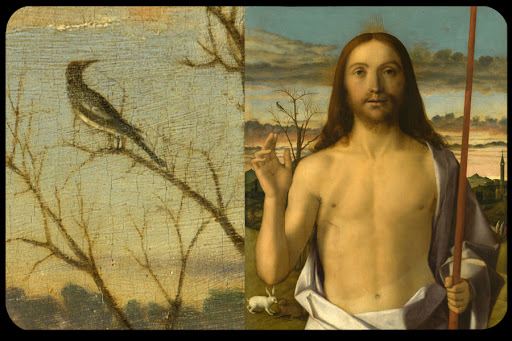As we think forward to the Easter season, I’d like to address a minor mystery in Christian iconography. I have what I regard as a good answer to my initial problem, but I’d really like confirmation. Are there any ornithologists out there?
The magnificent Kimbell Art Museum in Fort Worth, Texas, has a world-class collection of paintings from many different periods of European art. One of their great treasures is a painting from c.1500 called Christ Blessing, by Giovanni Bellini.
The subject is the Risen Christ. Around him, we see several lesser figures that reflect themes in the story. As the museum’s commentary remarks,
“Various motifs in the distant landscape allude to the Resurrection theme. … The pair of rabbits signify regeneration, while the shepherd tending his flock is a reminder that Christ, himself, is the Good Shepherd (John 10:14). The three robed figures at the right edge of the picture are undoubtedly the three Marys, who are hurrying to tell the disciples of the empty tomb. Above them the distant bell tower denotes that salvation is found through Christ’s sacrifice and the Church.”
All this seems highly plausible, and I’m sure it’s correct.
Look, though, at the upper left hand corner, where a bird sits on a branch. The commentary remarks, “On the left side of the panel, the withered tree with the solitary bird probably stands for the Old Covenant, out of which the New Covenant would grow.” Fair enough, but it is not just a generic bird, it is specifically painted to represent some particular species. Given Bellini’s fascination with iconography, it is unlikely to be just some specimen he had glanced at through a Venetian window. So why this bird?
Based on conversations with friends more knowledgeable than I am in these matters, I would identify it as a magpie. If so, that is significant, because in many systems of folklore around Europe, the magpie does have a special and somewhat sinister connection with the crucifixion. That grows, probably, out of its parti-colored character, neither all black nor all white. Accordingly, the magpie committed the dreadful crime of failing to don proper mourning for Christ at the time of his death. In various cultures, the magpie is condemned for its failure to comfort or assist Christ.
Can I say, then, that the magpie on the dead tree does indeed represent the old world, and perhaps the world that ignored Christ at the time of his death, but which will soon acknowledge his return in glory? To the best of my knowledge, I have never seen the magpie used in the context of the Old Covenant.
As a footnote, magpies also feature in another famous but enigmatic painting. In 1568, the elder Pieter Bruegel painted The Magpie on the Gallows. (A detailed image is available here). Art historians debate its meaning, but again we have the magpie in the context of execution, perhaps viewed as a modern-day version of the Crucifixion.
Feedback would be appreciated!
Philip Jenkins is a Distinguished Professor of History at Baylor University and author of The Great and Holy War: How World War I Became a Religious Crusade.

